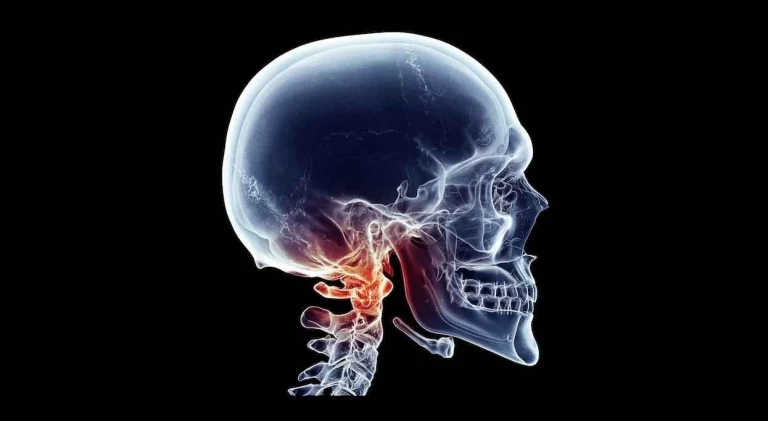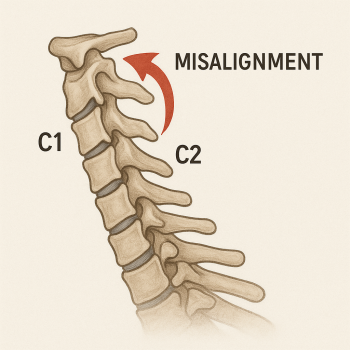
Understanding Neck Curve
One of the most underrated elements of physical health and performance is the appreciation for how the human body is oriented in gravity. We live, work, and play in an upright posture. Whether standing in line at the grocery store, sitting at work, or running on an outdoor trail, the forces of gravity are always bearing down on our frame. While this may be a vulnerability for some, knowing when and how to make improvements in our posture and structure is essential for long term functionality. The cervical spine (neck region) is the epicenter for many issues related to pain and poor function, and is the key to maximizing your ability to feel good and perform at your best.How to “Read” Neck CurveWhat exactly makes the neck region of the spine the “epicenter” of your structural framework? There are several characteristics that make this region of the spine particularly vulnerable:
1. it is the most freely movable part of the spine
2. it supports the weight of the head (10-13 pounds on average)
3. it lacks muscular support
To further understand this point, consider the following example. When building a suspension bridge, the smooth arc-shape of the bridge allows it’s components to work together for structural stability. Without large pylons underneath of the center of the bridge, support and safe use depends on proper structural orientation.
The human frame also shares a similar characteristic in that it contains a main beam (spine) that maintains 3 general curves in the neck, mid back, and low back. These curves are designed to produce maximum stability and strength under the extreme forces that our lifestyle produces. The neck region of the spine is the only curve of this structure that is only anchored at one end (on the shoulders). This makes this particular curve vulnerable to shifting out of its normal orientation producing a strain to the system.
You may have noticed teenagers who have developed “text neck” – or a postural distortion that involves a shifting forward of the head. This puts a tremendous amount of strain on the joints, ligaments, and nerves of the spine which eventually leads to the onset of secondary conditions (symptoms). While a range of dysfunction exists (much like high blood pressure or body mass index), this is an extreme example of how the neck curve can become compromised.
What Can Cause Neck Curve Problems
Neck curve problems most likely arise when structural stress overcomes the resistance of the supporting tissues of the neck. There are a variety of ways that this can occur, but generally speaking an accumulation of injuries and stresses add up over time causing neck curve problems.
The average patient with neck curve problems has experienced a past neck trauma such as a whiplash type injury including car accidents, sports injuries, concussions, etc. They may also have additional micro-stresses such as poor posture, sitting at a desk all day, deconditioned muscles, etc. For most individuals with neck curve problems, a series of these forces have added up over time to produce symptoms such as:
- Neck pain
- Pinched nerves
- Shoulder pain
- Headaches/migraines
- Carpal tunnel syndrome
- Limited range of motion
- Degenerative disc disease
- Spinal arthritis
These issues develop slowly over time as the stress of an abnormal neck curve produces strain on the muscles, tendons, ligaments, discs, and nerves of the cervical spine.
What to do About Neck Curve Problems
A reasonable person can understand that structural problems require structural solutions. Many people who are suffering with the symptoms of an neck curve problem will try to alleviate their pain with remedies such as over the counter medications, hot or cold packs, and often by limiting their activities to avoid discomfort. While these strategies may provide temporary relief, they are not addressing the underlying problem which lies in the poor alignment of the cervical spine and a breakdown of its structural integrity.
In order to achieve a maximal recovery from neck curve problems, the structural curve of the neck must be analyzed and treated. Typically treatments are not focused on making the curve perfect, but in directing it back toward it’s normal orientation in a way that is sustainable and provides lasting relief.
Most Common Reasons Adults Have Neck Curve Problems
There are two forces that are continually working against your neck curve – gravity and time. Many adults with neck curve problems have suffered from an initial injury that caused a structural shift in their neck. Over time the wear and tear of everyday life adds up to make this problem worse. Many adults also lose strength in the muscles that support the neck curve, which contributes to an acceleration of the problem. Since many adults have jobs that require them to sit for long periods of time, poor posture and ergonomic positions also contribute to neck curve problems getting worse for adjults.
Most Common Reasons Children Have Neck Curve Problems
Poor posture and neck curve problems is becoming a significant threat to the long term health of children and teens. There is an increasing incidence of neck curve problems among children for a variety of reasons. First and foremost, the increased utilization of technology (cell phones, tablets, etc) both at school and at home causes the potential for a large amount of stress to the neck curve. Sustained postures of looking down with the neck curve tilted forward causes tremendous strain on the muscles, ligaments, and nerves of the neck curve in kids. Additionally, children and teenagers are not yet fully developed in their skeletal system. This means that as they continue to grow, these strained postures may cause early degenerative changes to occur later in life.
Diagnostic for Neck Curve Problems
The only way to properly diagnose neck curve problems is with cervical spine imaging. X-ray measurements are necessary to determine if the neck curve has become compromised, the degree of abnormality, and the proper corrective treatment.
Most Common Reasons Adults Have Neck Curve Problems
There are two forces that are continually working against your neck curve – gravity and time. Many adults with neck curve problems have suffered from an initial injury that caused a structural shift in their neck. Over time the wear and tear of everyday life adds up to make this problem worse. Many adults also lose strength in the muscles that support the neck curve, which contributes to an acceleration of the problem. Since many adults have jobs that require them to sit for long periods of time, poor posture and ergonomic positions also contribute to neck curve problems getting worse for adjults.
Most Common Reasons Children Have Neck Curve Problems
Poor posture and neck curve problems is becoming a significant threat to the long term health of children and teens. There is an increasing incidence of neck curve problems among children for a variety of reasons. First and foremost, the increased utilization of technology (cell phones, tablets, etc) both at school and at home causes the potential for a large amount of stress to the neck curve. Sustained postures of looking down with the neck curve tilted forward causes tremendous strain on the muscles, ligaments, and nerves of the neck curve in kids. Additionally, children and teenagers are not yet fully developed in their skeletal system. This means that as they continue to grow, these strained postures may cause early degenerative changes to occur later in life.
Diagnostic for Neck Curve Problems
The only way to properly diagnose neck curve problems is with cervical spine imaging. X-ray measurements are necessary to determine if the neck curve has become compromised, the degree of abnormality, and the proper corrective treatment.
As with any diagnostic imaging, additional testing is appropriate for determining if, when, and how x-rays need to be performed. The combination of symptoms, history of injury, and postural and tissue related dysfunction (muscle spasms, weak muscles, tender joint capsules, etc.) help to determine when imaging is needed to diagnose neck curve problems. Doctors of chiropractic are at the forefront of healthcare providers who are properly trained in performing these testing procedures and developing a proper treatment plan.
Chiropractic Treatment for Neck Curve Problems
Chiropractic care is focused on correcting the abnormal structural alignment of the spine in order to maximize functionality, prevent long term disability, and achieve lasting relief from neck curve problems. Just like other healthcare fields such as dentistry or physical therapy, there are different categories of providers within chiropractic. The vast majority of chiropractors are focused in conventional chiropractic care. This approach is effective for temporary pain relief, minor musculoskeletal injuries, and generalized issues and typically is less specific in application. Upper cervical chiropractic is a conservative and focused area of chiropractic that focuses on correcting the problem rather than patching over the symptoms.
Upper cervical chiropractors use advanced imaging, testing, and procedures to correct the structural shifts at the top of the neck where the neck curve is most vulnerable. By safely and effectively correcting this part of the spine, the muscles that support the neck curve can receive proper nerve supply, the joints that make up the neck curve can move properly, and the weight of the head can be returned to a balanced position over the neck curve to reduce stress.
The Blair Upper Cervical Chiropractic approach is a comprehensive method of analyzing and correcting issues with the neck. To consult with a qualified Blair Upper Cervical Chiropractor near you, search our directory of providers or simply request a consultation.







Leave a comment